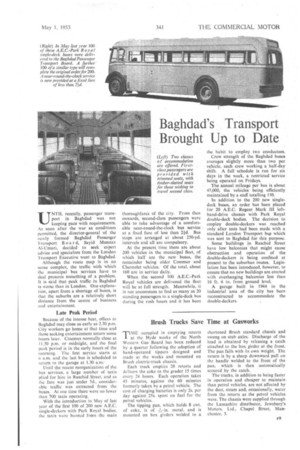Baghdad's Transport Brought Up to Date
Page 99

If you've noticed an error in this article please click here to report it so we can fix it.
UNTIL recently, passenger transport in Baghdad was not keeping pace with requirements. As soon after the war as conditions permitted, the director-general of the newly formed Baghdad Passenger Transport Boa r d, Sayicl Mumtax Al-Umari, decided to seek expert advice and specialists from the London Transport Executive went to Baghdad.
Although the route map is in no sense complex, the traffic with which the municipal bus services have to deal presents something of a problem. It is said that peak traffic in Baghdad is worse than in London. One explanation, apart from a shortage of buses, is that the suburbs are a relatively short distance from the centre of business and entertainment.
Late Peak Period
Because of the intense heat, offices in Baghdad may close as early as 2.30 p.m. City workers go home at that time and chose seeking entertainment return some hours later. Cinemas normally close at 11.30 p.m. or midnight, and the final peak'period is in the early hours of the morning. The lirst service starts at 6 a.m. and the last bus is scheduled to return to the garage at 1.30 a.m: Until the recent reorganization of the bus services, a large number of taxis plied for hire in Raschid Street, and as the fare was just under 5d., considerable traffic was extracted from the buses. At one time there were no fewer than 700 taxis operating.
With the introduction in May of last year of the first 100 of 200 new A.E.C. single-deckers with Park Royal bodies. the taxis were banned from the main
thoroughfares of the city. From then onwards, second-Class passengers were able to take advantage of a comfortable near-round-the-clock bus service. at a fixed fare of less than 24d. Bus stops are arranged at about 250-yd. intervals and all are compulsory.
At the present time there are about 200 vehicles in the municipal fleet, of which half are the new buses, the remainder being older Commer and Chevrolet vehicles. Of the total, about 160 are in service daily.
When the second 100 A.E.C.-Park Royal vehicles are delivered the fleet will be at full strength. Meanwhile, it is not uncommon to find as many as 20 standing passengers in a single-deck bus during the rush hours and it has been the habit to employ two conductors.
Crew strength of the Baghdad buses averages slightly more than two per vehicle, each crew working a half-day shift. A full schedule is run for six days in the week, a restricted service being operated on Fridays.
The annual mileage per bus is about 45,000, the vehicles being efficiently maintained by a staff totalling 150.
In addition to the 200 new singledeck buses, an order has been placed for 20 A.E.C. Regent Mark In lefthand-drive chassis with Park Royal double-deck bodies. The decision to employ double-deckers was reached only after tests had been made with a standard London Transport bus which was sent to Baghdad for this purpose.
Some buildings in Raschid Street have low balconies that might cause obstruction and operation of the double-deckers is being confined at present to the suburban routes. Legislation has been introduced, however, to ensure that no new buildings are erected with overhanging balconies less than 16 ft. 6 in. from ground level.
A garage built in 1944 in the industrial area of the city has been reconstructed to accommodate the double-deckers.








































































































































































































































